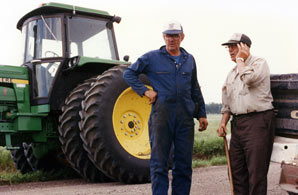 Only 0.2% of U.S. population is producing most of its food. The average age of
U.S. farmers is currently fifty-six.
Only 0.2% of U.S. population is producing most of its food. The average age of
U.S. farmers is currently fifty-six.US Census Bureau
We suffer a net loss of 32,500 farms a year. 88% of average farm household income is derived from off-farm.
PrairieFire for Rural Action
U.S. farmers apply nearly 45 billion pounds of synthetic fertilizers each year. From 1990-1994, food processors and manufacturers showed an annual average return on their investment of 17.9%. Farmers during the same period showed a 1.98% return on their investment.
PrairieFire for Rural Action
In 1971 a new tractor cost $20,000 and wheat was $1.71 a bushel. In 1994 a new tractor of the same horsepower cost $100,000 and a bushel of wheat was $2.66.
Des Moines Register 7/16/94
Soil loss costs the U.S. economy around $44 billion a year. Worldwide, the number is well over $200 billion.
Dr. David Pimentel, Science magazine
Every pregnant woman in the world today has chemicals in her body that disrupt the endocrine system. These are transferred to the fetus as it grows. She also has measurable concentrations of endocrine disruptors in her milk that are transferred to the infant.
ERICE Statement 5/30/96
The World Resources Institute reports that, measured by traditional methods, the average farm shows an $80 per acre profit. If we calculate in all the costs of soil loss, water contamination, and environmental degradation caused by conventional farming practices, the average farm would show a $29 per acre loss.
Food in supermarkets travels an average of 1300 miles between production and consumption.
Out of every dollar Americans spend for food, ten cents goes to Phillip Morris, and six cents goes to Conagra.
PrairieFire for Rural Action

In a USDA study of twelve common food crops, from 35% to 80% of all samples tested had residues from one or more pesticides. This was after the samples had been washed, peeled and cored. In these residues were 12 different carcinogens, 17 different neurotoxins, and 11 different endocrine disruptors.
Environmental Working Group
Tree bark gathered from ninety sites around the world, from the tropics to the treeline, bears traces of chemicals related to DDT, lindane, chlordane, aldrin, and to 18 other pesticides and fungicides. Some chemicals used decades ago are still affecting the environment, often thousands of miles from where they were sprayed.
Associated Press 9/30/95
4.7 billion pounds of pesticides are annually applied to food crops worldwide. 1.25 billion pounds of pesticides were used in the U.S. in 1995, an all-time high.
EPA draft document June 1996
Assault rifles kill an estimated 250 people each year and pesticides kill an estimated 10,400 people each year, yet assault rifles have been banned while the use of pesticides is expanding.
Environmental New Weekly
Every spring, 18,000 pounds per day of herbicides wash down the Mississippi and into the Gulf of Mexico.
Environmental Working Group
Between 1950 (the beginning of the Chemical Age) and 1988, the incidence of all forms of cancer increased by 43.5%, adjusted for age. Mortality rates from cancer rose by 2.9%.
Environmental News Weekly
In the United States, despite the use of pesticides, 35% of potential crops are lost to insects, diseases, and weeds. In 1945, before synthetic pesticides came into use, crop losses were 33%.
Dr. David Pimentel, Cornell University
Sales of U.S. organic products increased from $2.31 billion in 1994 to $2.8 billion in 1995. This is a 22% increase, and the sixth year in which sales have grown by more than 20%.
Natural Foods Merchandiser survey, June 1996
The USDA states that total organic cropland is approximately 1,127,000 acres in 1996, up from an estimated 550,267 acres in 1991. The number of organic farmers almost doubled between 1991 and 1994, increasing from 2,841 to 4,060.
Check out our list of organizations that can help you go organic and support sustainable agriculture!

